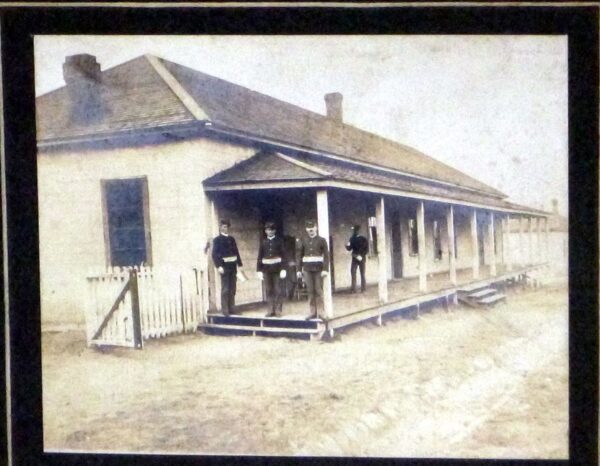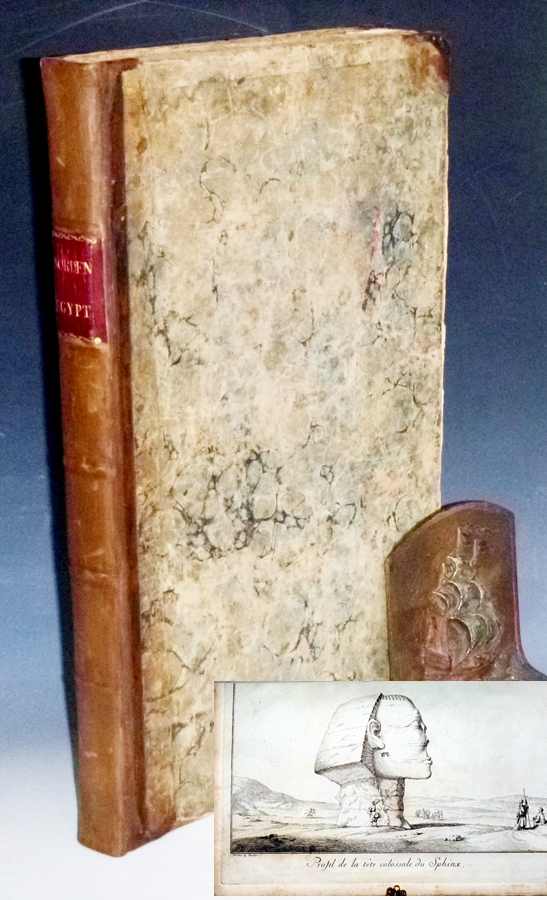Bezold, Carl; E.A. Wallis Budge
The Tell El-Amarna Tablets in the British Museum; with Autotype Facimilies
Printed By the Trustees, London: 1892
- $2,833
Quarto. xciv, 157 pages, 24 leaves of plates. A very rare book with the Akkadian text. In the autumn of 1887, the Amarna Archive was discovered. This led to new understanding of the proto-canaanitish influence on early Semitic languages. The work of Bezold, the Assyriologist scholar and Budge, the Egyptologist and Semitic scholar combined to make this the essential starting place for Akkadian (and early allied semitic languages). In this, the first edition of the Amarna letters in the British Museum (BB 1892) scholars realized these letters and dispatches were key to proto-canaanitish vocabulary and were related to Amenophis III. The Bookplates of S.D. Driver (Magdalen College, Oxford) and later of his son Sir. Geoffrey R. Driver, who also was an accomplished Semitic scholar, represent a very strong association copy, Bound in brown cloth over beveled boards, spine lettering gilt, yellow coated endpapers, some light scattered foxing mostly to the verso of plates. light wear to corners, joints rubbed, a handsome copy.
More from Alcuin Books
MSC Wiley Lecture Searies Poster: U.S. Interventionism: Resolving International Conflict
Advertisement poster for a lecture given to students and non-student April 1, 1986, 8:00 p.m. to 10:00 p.m. During the year 1986, the lectures were given by four important men; Former President Gerald R. Ford, Former President Jimmy Carter, Dr. Steven Ambrose and Pulitzer Prize winning columnist George Will. The MSC Wiley Lecture Series was founded in 1982 to bring some of the world's most renowned public leaders, policy officials, and academic experts to Texas A&M University. Presented once a year, the Main Program takes the form of a lecture or panel discussion presented in a large forum at Texas A&M. The event typically boasts an in-house audience of around 2500 attendees. The poster measures 22" x 13" and signed by all four men. A fine poster save for two tiny pin holds used for hanging.The History of Envelopes
Ramage, Robert Small Octavo. 84 pages including bibliography. The early history discusses how documents were covered (usually for secrecy by kings and dictators). By the early 16th century envelopes were used to transmit documents. A very nice copy bound in blue cloth lettered and decorated in gilt, spine lettering gilt, a few tiny spots of white to upper board, protected in mylar.- $46
- $46
Maggie-Now
Smith, Betty Octavo. 437pp. After her success with A Tree Grows in Brooklyn, the author now traces the story of Maggie-Now whose faither left Ireland at the end of the 19th century and his misadventures in coming to America. She is now carrying for him in a world without today's social programs. A very good novel bound in 1/4 black cloth over blue cloth stamped in orange depicting a bridge, spine lettering red and gilt, previous owner's bookplate, in unclipped pictorial dust jacket rubbed along the edges and some chipping to spine ends and corners.- $180
- $180
Prehistoric Man of the Santa Barbara Coast; a Synopsis of the Results of Four Years of Intensive Investigation, Conducted by the Author for the Museum of Natural History of Santa Barbara, California.
Rogers, David Banks Octavo. xvii, 452 pages, index. Profusely illustrated. Tod Oviatt's copy (see page xv). The author saw the rapidly vanishing remains of villages that in former times occupied the Santa Barbara Valley. He deals with the early Indian, Spanish and the Oak Grove culture. He has dealt in detail with the historical background of the Chumash. This was the first important book on the earliest primitive cultures in the Santa Barbara valley, from an archaeological and anthropological point of view. A very nice copy bound in maroon cloth lettered in gilt, spine lettering gilt but dulled, previous owner's book plates and inscription from Tod Oviatt. Only very minor spots of rubbing. Very nice.- $180
- $180
Baralam and Yewasef being the Ethiopic version of a Christianized recension of the Buddhist legend of the Buddha and the Bodhisattva
Budge, Sir E.A. Wallis Octavo. Volume 2. cxi, 351 pages. Illustrated with 73 plates. Budge's summarized introduction shows that practically every nation from China to Ireland and from Mongolia to Abyssinia had loved to read the stories, credible, semi-mythical, and fabulous, which have sprung up round the name of Alexander the Great. Every known version of the legendary history of Alexander is based upon the Greek history falsely attributed to Callisthenes, his companion and friend that the Egyptians made Alexander to be an incarnation of one of their old primeval gods by a Macedonian queen. And, that the Christians made him a kinsman and an associate of the Patriarchs, and later a prophet and a repository of the secrets of Christ, and finally a Christian. An earlier volume in the series provided the Ethiopic text. The mythology was recognized by J. Frank Dobie in his "Between the Comanche and the Rattlesnake" (Southwest Review, 1955, p. 40ff.). Bound in rust pictorial gilt cloth, spine lettering gilt but dulled, only light wear to corners and spine ends, front and rear hinges apparently reglued, previous owner's bookplate and small bookseller's ticket to front pastedown, internally clean without foxing.- $273
- $273
The Egyptian Sudan: Its History and Monuments (2 Vol set)
Budge, E. A. Wallis Large Octavo. In 2 volumes. Vol. I xxviii, 652 and Vol. II, x, 618 pages, index, both volumes extensively illustrated. Budge traveled extensively. This book is a classic on his travel, discovery, and the key work on the Sudan after the 1821 version. The first part is a brief narrative of the results of four Missions, and a description of the temples, pyramids and more with the help of his friends Lord Kitchener, Sir Reginald Wingate and their staffs. With their help he was able to visit, examine and partly excavate these historic areas. The second part of this work deals with the history of the Sudan. The narrative begins with the great raid made in the country by Seneferu, a king of Egypt, who reigned about B.C. 3766, and ends with a summary of the principal events which took place there in A.D. 1904. Bound in maroon pictorial gilt cloth depicting an native with palm trees in the back, lettering and top edge gilt, some spots of rubbing with wear through to corners, rear hinge of volume two cracked and front hinge starting. Spines of both volumes have markings where labels were apparently inset, but not an ex-library set, no names or book plates, internally clean without foxing.- $361
- $361
Egyptian Magic
Budge, E. A. Wallis Small Octavo. 3rd impression. (First published in 1899, 2nd impression 1901). .xv[xvi-xviii], 234 pages illustrated with 20 illustrations. Subjects contained in this volume; Antiquity of magical practices in Egypt -- Magical stones or amulets -- Magical figures -- Magical pictures and formulae, spells, etc. -- Magical names -- Magical ceremonies -- Demoniacal possession, dreams, ghosts, lucky and unlucky days, horoscopes, prognostications, transformations, and the worship of animals. Bound in orange cloth lettered and decorated in black, spine lettering black, previous owner's bookplate, some bubbling to cloth. A very good copy.- $386
- $386
One Hundred and Ten Miracles of Our Lady Mary
Budge, Sir E.A. Wallis Octavo. Frontispiece, viii, 359 pages, Sixty-four full page black and white plates. This is the companion volume to the Legends of Our Lady Mary the Perpetual Virgin which was published in November, 1922. A collection of one hundred and ten tales of miracles related to the Virgin Mary, translated From Ethiopic manuscripts: "The original texts, with English translations, of about forty of these were published by me in the volume "Miracles of the Virgin Mary", which Lady Meux printed for private circulation in 1900." Bound in blue pictorial gilt cloth, spine lettering gilt, rear hinge had been reglued, light wear to corners, front portion of dust jacket laid in, bookseller's ticket. A very good copy of this scarce work.- $335
- $335

4′ x 5″ Original Photograph of Old Fort Apache (circa 1890)
A nice sepia photograph of Old Fort Apache Adjutant's Office with officers standing on porch. The adjutant's office, built of adobe in 1875 was maintained even after Geronimo's surrender. They still were tryiing to capture the Apache Kid and Massai as well as move squatters from the Apache reservation.- $155
- $155

The Antiquities, Natural History, Ruins, and Other Curiosities of Egypt, Nubia and Thebes;exemplified in Near Two Hundred Drawings Taken on the Spot
Norden, Martin F. Folio. When Frederick Ludwig Norden went to Egypt in 1737 on an exploratory mission, he was the first European to penetrate as far as Derr in Nubia and to publish descriptions of the Nubian temples. He died in 1757 but fortunately his work was completed with engravings of Mark Teuscher. This work was projected to have up to 200 engravings but 164 were all ever issued which includes a portrait of the author. This very rare posthumous publication of The Antiquities, with its wonderfully detailed and realistic plates has survived in beautiful condition (there is a scarce edition issued in 1792), the Danish master engraver Carl Marcus Tuscher worked on his friend Norden's work in London. The engravings when finally published captured the European imagination about Egypt in a way that was to dominate the dramatic research for the next several centuries. The work remains to this day a valued primary source on the appearance of Egyptian monuments before the widespread excavations and tourism of the 19th and 20th centuries - including the first ever depiction of The Great Sphinx missing its nose. All 164 engravings are present as in all recorded copies. (NYPL has all the images online). Bound in ¾ calf over marbled paper covered boards, earlier rebacking retaining the original endsheets and morocco spine label laid down, pencil notes on rear endpaper from previous owner's collation. Some ocassional light scattered foxing to few plates, margins toned. Very rare.- $11,845
- $11,845
The Tell El-Amarna Tablets in the British Museum; with Autotype Facimilies: https://rarebookinsider.com/rare-books/the-tell-el-amarna-tablets-in-the-british-museum-with-autotype-facimilies/